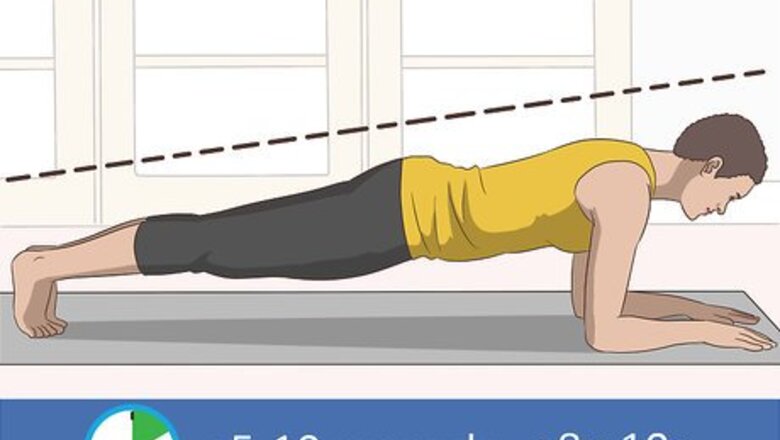
views
Corrective Exercises
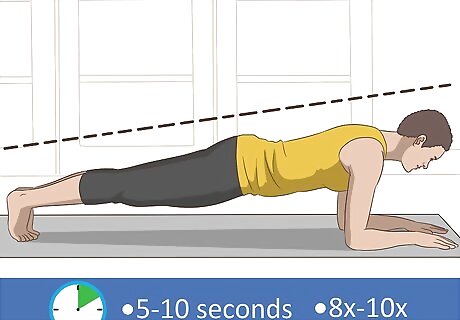
Hold a plank position for 5-10 seconds at a time to strengthen your back. Start lying down on your stomach, and prop your body up on your forearms and toes. Make sure that your feet are parallel to each other. Raise your hips and keep your head and neck straight so that you create a straight line from head to toe. Hold this pose for 5-10 seconds, and repeat the exercise 8-10 times. If you struggle with your plank initially, gently touch your knees to the ground. Keep your core engaged. Use your knees to stabilize you, but not to hold your weight. Planks help strengthen your core and lower back, the muscles responsible for keeping your back straight.
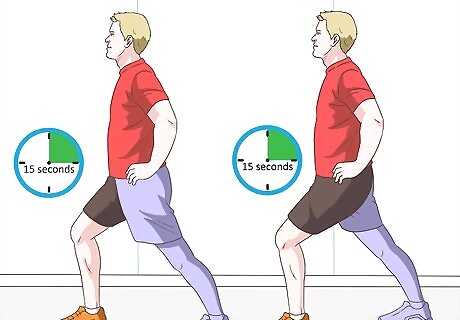
Stretch your hip flexors for 15 seconds. Start in a standing position with a straight spine and your arms sitting gently on your hips. Step one foot forward, bending at the knee and keeping both feet pointing forward. Keep your back leg straight and your buttock tucked. Push forward on your front leg until you feel a stretch in your back leg. Hold the stretch for 15 seconds on each leg. Repeat the stretch 3-5 times a day, or whenever your hips feel tight. You should feel a stretch, but there shouldn't be any pain. If you feel painful pulling in your muscles, stop immediately. This helps open your hips to promote proper posture, which will slowly help minimize your lordosis.
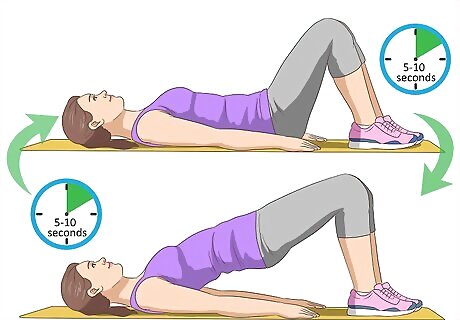
Repeat bridges for 1-2 sets of 10 reps to build core strength. For a bridge, start by lying on your back with your knees bent so that your feet are flat on the floor. Keep your palms and forearms next to your torso, pushing into the floor. Push your buttocks off the floor, lifting them as high as possible while keeping your arms, shoulders, and neck flat on the ground. Hold each bridge for 5-10 seconds before lowering your buttocks down slowly. Rest for 5-10 seconds before repeating the exercise. Always check your body alignment before you start the exercise. If you feel strain or pressure in your neck or shoulders or a sharp pinch in your lower back, stop immediately.
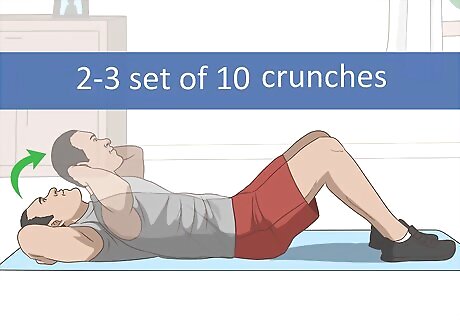
Do a set of 10 abdominal crunches to strengthen your core. Lie on your back with your knees bent and your feet flat on the floor. Hinge at your hips and use your core to pull your upper body toward your knees. You don’t need to sit all the way up, but your head and shoulders should come off the floor. Aim to build up to 2-3 sets of 10 crunches, resting for 30-60 seconds between sets. Check with your doctor or physical therapist before attempting crunches. Do not lift your body from your neck or pull on your head and neck while coming up into your crunch. This is not only ineffective, it can also be dangerous if you pull too hard.
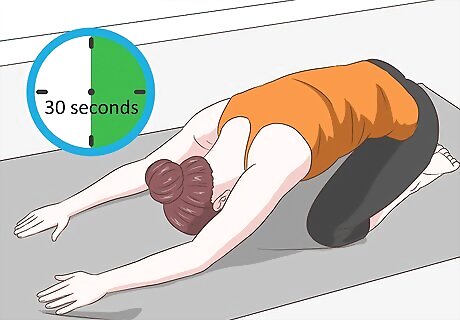
Hold a child’s pose stretch for 30 seconds to open your hips. Kneel on a soft floor or an exercise mat, sitting on your heels. Move your knees hips’ width apart. Hinge at the hips and bring your upper body as close to the floor as possible, keeping your head facing straight down. Stretch your arms straight out in front of you so that you feel a stretch in your spine. Child’s pose is a resting pose. If you’re comfortable in it, hold it for up to 2 minutes whenever your hips are tight. Stop holding the pose if you experience any discomfort. Child's pose is not a pose where you should feel an intense stretch.
Prevention
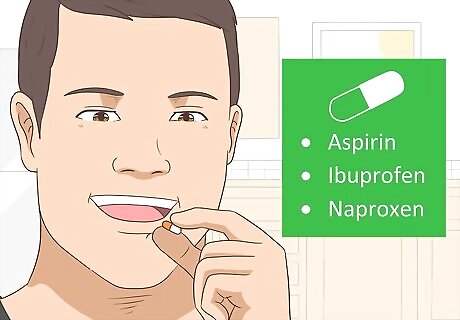
Use nonsteroidal anti-inflammatory drugs (NSAIDs) to manage swelling. NSAIDs such as aspirin, ibuprofen, and naproxen help relieve swelling that can worsen lordosis, along with any associated pain. Take the medication as directed on the product packaging or as otherwise directed by your doctor. Always talk to a healthcare professional before starting any new drug, even if it is over-the-counter.
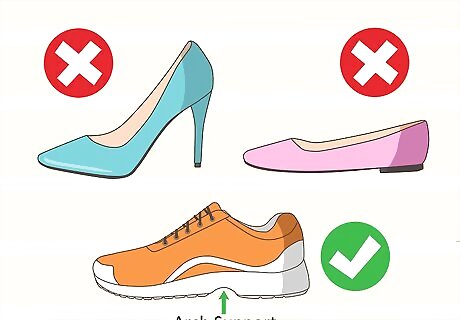
Wear shoes with good arch support. High heels and shoes with flat insoles do not provide the support you need for proper posture. Invest in shoes that offer good arch support to help keep a straight posture that doesn’t force out your backside. If you have flat feet or high arches, consider getting a professional fitting for insoles or orthotics. Your doctor can recommend you to a podiatrist, or you can talk to a professional at a local medical shoe store. You can find shoes with arch support in specialty shops, such as at your local mall and online.
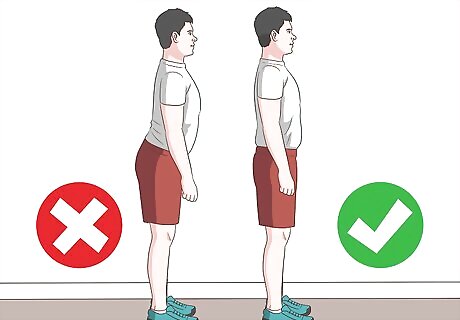
Practice better posture by drawing your tailbone in when standing. When you stand, draw your tailbone in toward your waist so that it’s not sticking out toward your backside. Keep your weight evenly distributed between your feet. Press your heels down and pull your chest up away from the hips. Better posture will take time and practice. Try to keep the best posture you can, but don’t get upset if your posture doesn’t automatically improve. Imagine, there are weights on your feet keeping your legs grounded while a balloon pulls you up from the top of your head. Check your posture by looking in a mirror. Make sure your shoulders are at the same height.
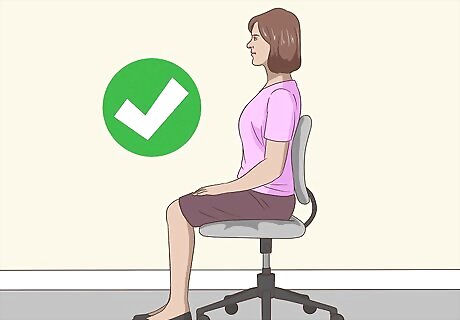
Sit centered on your buttocks for better seated posture. To improve your seated posture, keep your weight evenly centered between your buttocks. Lift your chest and drop your shoulders down toward your hips. Keep your lower abdomen tucked in so that your spine is as straight as possible. Avoid sitting to one side or with your legs tucked under you whenever possible.
Medical Treatments
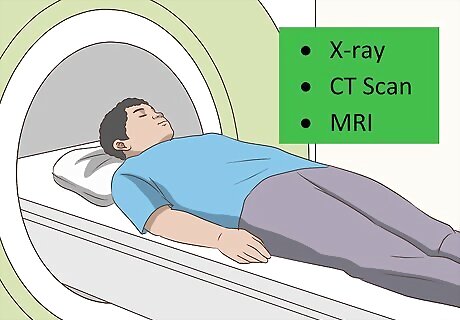
See a doctor to diagnose the cause of your hyperlordosis. Understanding the cause of your lordosis allows you to customize a treatment plan, since different causes of lordosis may require different treatments. Your doctor may order tests, such as an X-ray, CT scan, or MRI to look for potential causes. Make an appointment with a healthcare professional to determine the cause of your lordosis and talk about the best treatment options for you. Common types of lordosis include: Postural lordosis caused by carrying excessive weight in the front of the body. Traumatic lordosis caused by fractures connecting the links of the spine. Post-surgical lordosis that occurs after a laminectomy. Neuromuscular lordosis caused by a wide range of neuromuscular disorders. Lordosis caused by a contracture of the hip joints. Birth lordosis due to childbirth involving a baby which is too large for the Uterus.
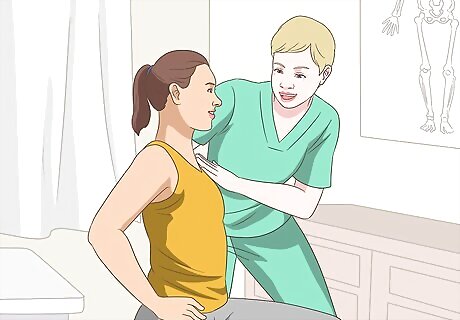
Meet with a physical therapist to train weak muscle groups in your back. Once you know the cause of your lordosis, a physical therapist can customize a treatment plan to help you fix it. They will teach you exercises that help strengthen your weak muscle groups and treat the specific causes of your lordosis. Lordosis caused by carrying excessive weight in the front, for example, requires exercises that strengthen the lower back while lordosis caused by hip problems requires hip exercises. Your physical therapist will help you find the right exercises for you.
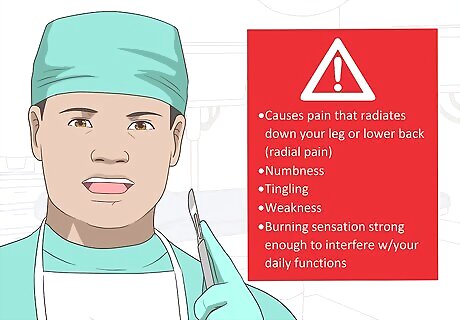
Ask your doctor about surgery for extreme cases. Surgery is only recommended for the most extreme cases where the lordosis also causes nerve problems. If your lordosis causes pain that radiates down your leg or lower back (radial pain), numbness, tingling, weakness, or a burning sensation strong enough to interfere with your daily functions, ask your doctor if surgery is the right option for you. If your doctor believes you are a good candidate for spinal surgery, they will recommend you to a surgical specialist. The specialist may perform additional evaluations to make sure surgery is the best option. Spinal surgery is usually followed by physical therapy to help advance the recovery process.













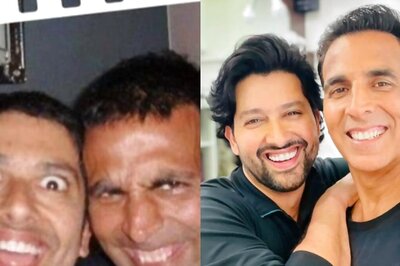




Comments
0 comment